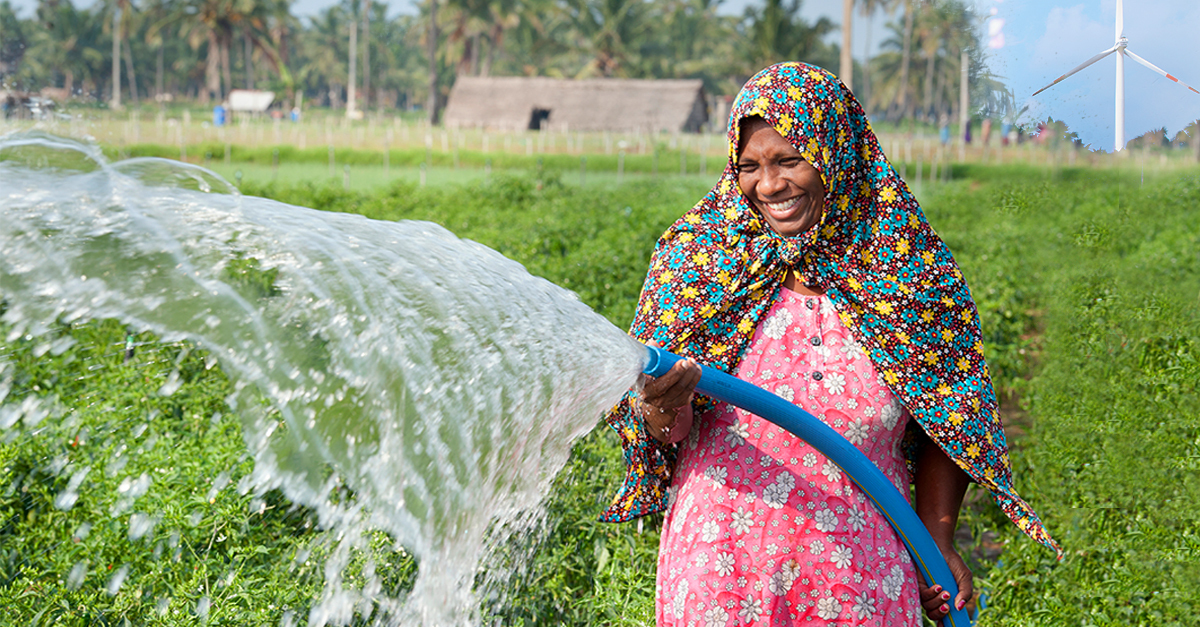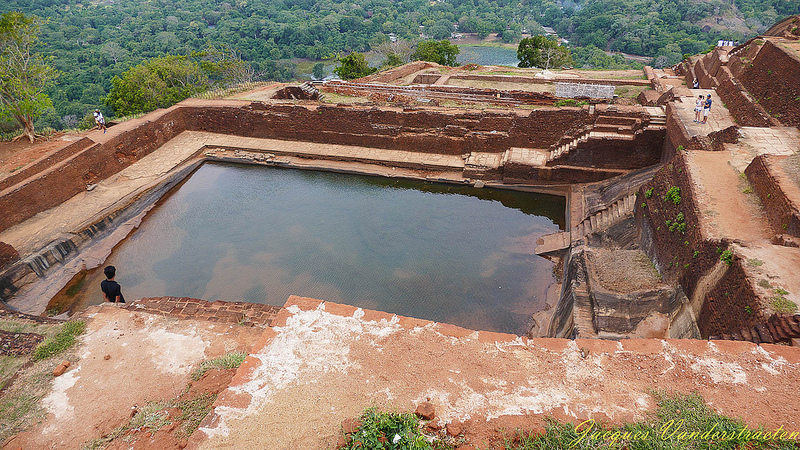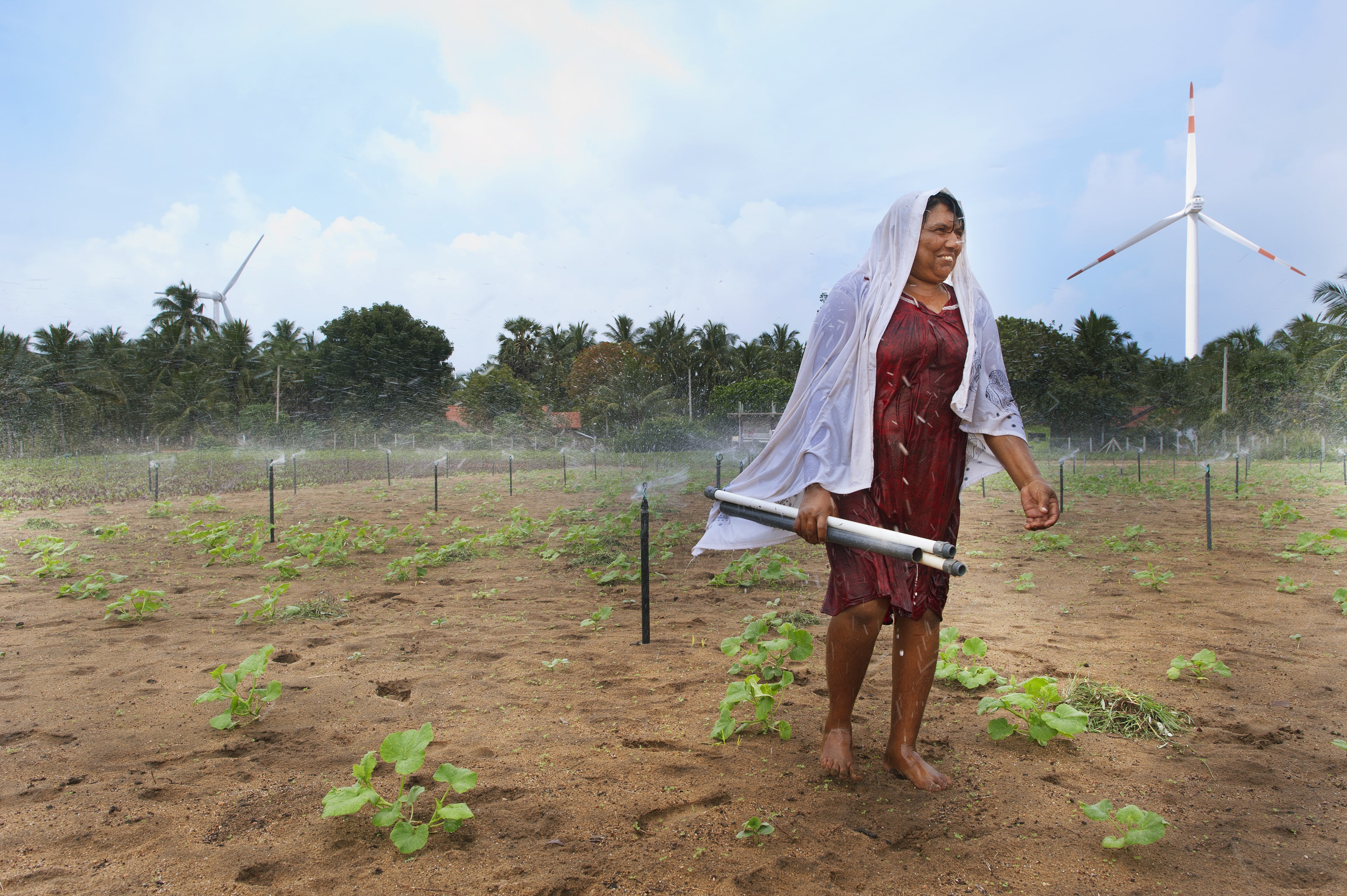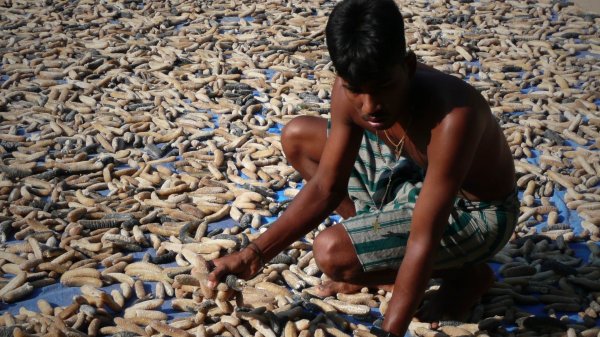
We step out into the torrid Kalpitiya sun to find ourselves staring at an expanse of tobacco plants, swaying faintly in the breeze from the ocean behind us. As we walk towards the farm, sand jams its way between the soles of our feet and the surface of our shoes.
Continuing towards the site we are visiting, it becomes clear that this land nurtures much more than just tobacco. Beets, chillies, potatoes, and guavas are all growing in the same desiccated sand we are standing on — thriving in the searing heat.
Given Kalpitiya’s arid climate, the production of such a large variety of crops is an impressive feat, as it requires a reliable supply of water that can stretch throughout the year. This is impossible to achieve using traditional irrigation techniques, which involve building canals to direct water away from rivers or lakes and into the soil.
“All our crops are harvested using water from under the ground,” explains M. L. Jesus, a farmer and agro-entrepreneur from the Kalpitiya Peninsula. He points towards a vertical PVC pipe jutting out of the ground, with a valve taped to the top of it. “It gets pushed through here, usually through motor pumps.”
Like his father, Jesus has been a farmer his entire life. He gained a diploma in agro entrepreneurship at Aquinas College in Maradana, enabling him to learn how to innovate and develop technology within his field. Along with Jesus and his father, there are 400 families from surrounding villages that cultivate about 500 hectares of land on the Peninsula.
Groundwater is the only source of water in the Kalpitiya region, so it makes sense that farmers have developed the technology to harness it. But as surface water becomes more and more scarce around the region, the techniques used in Kalpitiya could be a plausible alternative to more traditional irrigation methods.

Canal Irrigation Techniques
Water is one of the most critical components of agriculture. It is also the most volatile, making a reliable supply using traditional farming methods extremely difficult in Sri Lanka. This is particularly true in the dry zone, where rainfall is limited.
Canal irrigation techniques have existed in Sri Lanka since ancient times, and to this day, remain a popular method of irrigation in the country.
“This system involves harnessing and storing rainwater in large reservoirs. How it works now is that whatever the amount that gets collected in a reservoir every monsoon, then gets divided up and distributed to farmers in the region,” said Mohamed Aheeyar, a researcher at the International Water Management Institute (IWMI).
Under this system, farmers have to ration out the supply they are given. They do not have their own supply and are completely dependent on what is allocated to them.
“These farmers are restricted to growing just one crop, which will usually [produce] a yield twice a year. A large portion of this yield is consumed by the farmer, leaving behind a small amount to use for commercial purposes,” said Aheeyar.
This subsistence-based lifestyle is becoming increasingly insecure for farmers in the country, with many abandoning the profession by moving into cities to seek out white collar jobs. But others are finding workarounds by exploring alternate sources of water.

Water From The Ground
Over the last few decades, farmers have been increasingly turning to groundwater as their main irrigation source. Through this method, they are able to install their own irrigation pumps to draw underground water, allowing them to irrigate crops at will, as opposed to rationing a fixed amount that is given to them. This allows them to cultivate many different crops throughout the year, and sell the majority of what they produce.
However, in many areas, the resource is over-exploited.
“The groundwater that farmers can use for agriculture is sandwiched between a layer of brackish water at the top, and salt water at the bottom,” explained Palitha Senadheera, District Assistant Commissioner of Agrarian Development at the Department of Agrarian Development in Puttalam. “This can be tricky, because if too much water gets pumped out, farmers run the risk of infiltrating the layer of saltwater, and that can cause serious damage to crop yields.”
In Kalpitiya, farmers have used micro-irrigation techniques to mitigate this risk.
This manifests as a careful, intricate sprinkler system that pumps out water harnessed from a diesel-powered motor. The contraption consists of several pipes— bought from the grocery store — that branch out horizontally from the motor. At the end of each branch, the farmers have attached taps —specifically picked to regulate pressure— that spray water from all sides, covering an allocated circumference of the field.

By investing in this technology, which includes tubewells to store the groundwater, the farmers have managed to expand the area under cultivation. In an area like Kalpitiya, where fertile soil is scarce, and rainfall is confined to a mere four months of the year, this is a remarkable achievement.
All the technology was developed by the farmers themselves, which is one of the reasons that it has become so successful.
“As a farmer who has lived here and been growing on this land for generations, I have an understanding about how much water to use, and the right amount of pressure and force needed to pump it correctly,” said Jesus. “So this technology works, because I helped develop it. When we get the technology from the government, it always pumps out too much water, and the crops get damaged.”
Jesus is constantly looking for ways to maximise the efficacy of the project. With the help of the Agrarian Development Authority, Jesus and other farmers in the area have managed to introduce solar panels to a section of their farms. Half of the investment capital was provided for from the President’s Fund, and the rest needs to be paid back by farmers.
“Currently, I still owe the banks about 40 million rupees. Most farmers would not be granted loans like that, but the local council and banks have caught on to how successful we are, and want to invest in us” said Jesus.
While most of the sprinklers still use diesel, they are slowly shifting towards solar energy. This will allow them to gain a much higher profit margin in the long term, as they will be able to cut out diesel costs.
Jesus has been able to transform his family trade into a lucrative business, which has facilitated an agricultural boom in the area. When he started out, he would find himself working 19 hours days, seven days a week, to fulfill the labour required for a farm such as this. Now, he has grown successful enough to be able to hire workers to help tend to the farm.
Sprinkler technology has also enabled about 65 % of the farmers to change the types of crops that they cultivate. Crops that yielded for a short duration— such as ginger— were previously difficult to cultivate. This was because before sprinklers were introduced, the groundwater was channelled through a drag hose. It was extremely difficult to provide an evenly distributed supply of water using that system, which is a requirement for short duration crops.
Crops using farmer-led technologies such as the one in Kalpitiya could be used as an agricultural model for similar regions around the country. Farmers have managed to transform this relatively hostile region into one that is nourishing dozens of fruits, vegetables and grains. If this model can spread to other areas in the dry zones, it could transform the lives of farmers, and rejuvenate the agriculture industry.
However, in order to make it work, there is a high investment cost.
“To support the sprinkler irrigation systems, farmers needed two to three extra wells per hectare to irrigate the expand the land,” said Aheeyar.
These initial costs cannot be met by most farmers in Sri Lanka, and in order to implement this system, outside investment is needed. This can be a tricky decision for farmers to make, as many are hesitant to take out loans and invest in the long term.
“Many farmers in Sri Lanka do not have education about farming technology, and so they see our system as a big risk,” said Jesus. “In order to make something like this work, farmers need to break away from their traditional habits.”
Aheeyar also echoes a similar sentiment. He believes that in order for this system to work, inclusivity is the most important factor for governments to consider.
“We need to make sure that poorer communities also benefit from these technologies, as they are the ones who are mostly affected by water scarcity,” he said. “That requires investing in education for farmers as well as giving out bigger loans for farmers to effectively install these systems. If that happens, this model could revolutionise the agricultural industry in Sri Lanka.”







